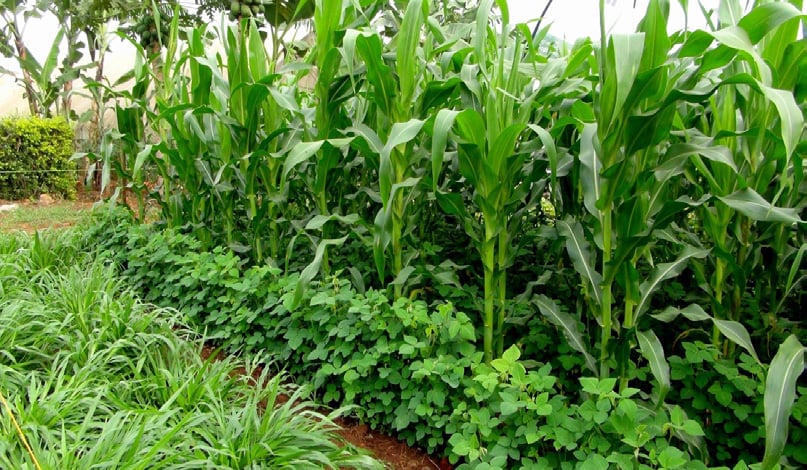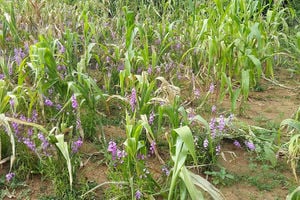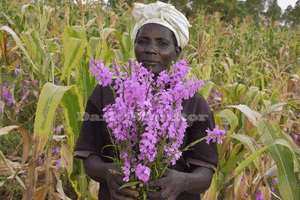
Climate-smart push pull field with Greenleaf desmodium. Photo | Courtesy
Stemborers and striga weeds cause significant losses to maize production throughout Africa. Maize yield losses due to stemborers can vary from 20 to 40 percent.
Striga weeds infest 40 percent of the arable land in sub-Saharan Africa, causing an annual crop loss of about $7 billion. Around the Lake Victoria basin, infestation by striga weed causes 30 to 100 percent loss in maize yield.
Weeding for striga control is both time-consuming and labour-intensive. The use of insecticides for stemborer control is not only expensive and harmful to the environment but is also ineffective.
Stemborers
Stemborers are one of the most destructive pests of cereal crops and can significantly reduce the yields of maize and sorghum on smallholder farms.
These pests can cause yield losses of 20 to 40 percent if they are not controlled. Controlling stemborers with insecticides is very expensive for resource-poor farmers and can also harm the environment.
Stemborers are the most destructive insect pests of maize in Africa, but they also attack other cereal crops such as sorghum, millet, and sugarcane. In eastern Africa, two species of stemborers cause heavy damage to cereal crops: Busseola jusca and Chilo partellus.
The adult moths of stemborers are seldom seen in farmers’ fields as they are inactive during the daytime.
They become active after sunset and lay their eggs during the night. Adult moths lay their eggs on maize plants; after the larvae emerge, they feed on leaves for two to three days and enter the maize stem.
How it damages crop
Damage is caused by the worm-like larvae, which first feed on young leaves but soon enter into the stems. During the early stage of crop growth, the larvae may kill the growing points of the plant, resulting in deadheart.
At a later stage of growth, the larvae make extensive tunnels inside the stem. This weakens the stalk, so it breaks and ‘lodges’ (falls over).
Damage caused by stemborers averages 20-40 percent, meaning that between 2-4 bags of maize are lost out of every 10 that could be harvested. When the larvae are fully grown, they pupate and remain inside the maize stem. After 7- 14 days, the adults emerge from the pupae and come out of the stem. They mate, lay eggs on the maize plants again, and continue damaging the crop.
Striga weeds
Striga weeds can cause maize yield losses of 30 to 100 percent or complete crop loss if they are not controlled. The weed grows by attaching itself to the maize plant.
Its roots penetrate the crop’s roots and start to draw nutrients from the maize. This causes severe stunting of the maize crop and yield loss. The push-pull strategy limits crop losses by Striga.
Striga or ‘witchweeds’ are parasitic weeds that affect cereal crops in many parts of Africa, reducing production or causing a complete crop failure. The most affected crops are maize, sorghum, rice and sugarcane.
If both stemborers and Striga weed attack maize plants, the yield loss is often 100 percent. In East Africa, there are two common species of witchweed, striga hermonthica, and striga asiatica. Striga hermonthica is common around the Lake Basin, while Striga asiatica is mainly found in the coastal areas.
When a farm is infested with striga, the affected plants seldom grow more than one foot (30 cm) tall.
The weed does not put roots into the soil to grow on its own but grows by attaching itself to the host (e.g., maize) plant.
Each striga plant can produce up to 20,000 – 50,000 seeds, which lie dormant in the soil until a cereal crop is planted again.
This dormancy can last for over 15 years. As striga germinates, its roots grow towards the host crop. They penetrate that crop’s roots and start to draw nutrients from the host. This causes severe stunting of the host crop and yield loss.
Taking into account the peculiar nature of striga seeds, farmers are advised to control it before the weed emerges above the soil. This is because, by the time it emerges, much of the damage to the maize will have been caused.
How does push-pull reduce maize losses?
Push-pull is a simple cropping strategy whereby farmers use Napier grass and desmodium legume as intercrops. Desmodium is planted in between the rows of maize. It produces a smell or odor that stemborer moths do not like. The smell ‘pushes’ away the stemborer moths from the maize crop.
Napier grass (Pennisetum purpureum) is planted around the maize crop as a trap plant.
Napier grass is more attractive to stemborer moths than maize, and it ’pulls’ the moths to lay their eggs on it.
However, Napier grass does not allow stemborer larvae to grow-survive on it. When the eggs hatch and the small larvae bore into Napier grass stems, the plant produces a sticky substance like a glue that traps them, and they die. So, very few stemborer larvae survive, and the maize is saved because of the ‘push-pull’ strategy.
In addition, a ground cover of desmodium, interplanted among the maize, reduces striga weed.
Research has shown that chemicals produced by the roots of desmodium are responsible for suppressing the striga weed. Therefore, striga does not grow where desmodium exists.
As a legume, desmodium also fixes nitrogen in the soil and thus acts to enrich the soil.




